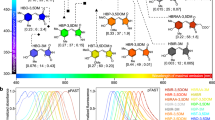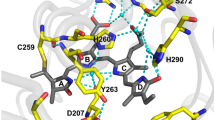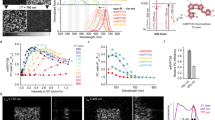Abstract
Fluorescent reporter proteins such as green fluorescent protein are valuable noninvasive molecular tools for in vivo real-time imaging of living specimens. However, their use is generally restricted to aerobic systems, as the formation of their chromophores strictly requires oxygen. Starting with blue-light photoreceptors from Bacillus subtilis and Pseudomonas putida that contain light-oxygen-voltage–sensing domains, we engineered flavin mononucleotide–based fluorescent proteins that can be used as fluorescent reporters in both aerobic and anaerobic biological systems.
This is a preview of subscription content, access via your institution
Access options
Subscribe to this journal
Receive 12 print issues and online access
$209.00 per year
only $17.42 per issue
Buy this article
- Purchase on Springer Link
- Instant access to full article PDF
Prices may be subject to local taxes which are calculated during checkout

Similar content being viewed by others
Accession codes
References
Matz, M.V., Lukyanov, K.A. & Lukyanov, S.A. Bioessays 24, 953–959 (2002).
Chudakov, D.M., Lukyanov, S. & Lukyanov, K.A. Trends Biotechnol 23, 605–613 (2005).
March, J.C., Rao, G. & Bentley, W.E. Appl. Microbiol. Biotechnol. 62, 303–315 (2003).
Tsien, R.Y. Annu. Rev. Biochem. 67, 509–544 (1998).
Losi, A., Polverini, E., Quest, B. & Gärtner, W. Biophys. J. 82, 2627–2634 (2002).
Krauss, U., Losi, A., Gärtner, W., Jaeger, K.-E. & Eggert, T. Phys. Chem. Chem. Phys. 7, 2804–2811 (2005).
Losi, A. Photochem. Photobiol. Sci. 3, 566–574 (2004).
Avila-Perez, M., Hellingwerf, K.J. & Kort, R. J. Bacteriol. 188, 6411–6414 (2006).
Buttani, V. et al. Photochem. Photobiol. Sci. 6, 41–49 (2007).
Swartz, T.E. et al. J. Biol. Chem. 276, 36493–36500 (2001).
Losi, A., Ghiraldelli, E., Jansen, S. & Gärtner, W. Photochem. Photobiol. 81, 1145–1152 (2005).
Patterson, G., Day, R.N. & Piston, D. J. Cell Sci. 114, 837–838 (2001).
Brown, J.M. Mol. Med. Today 6, 157–162 (2000).
Drepper, T. et al. Biotechnol. J. 1, 777–786 (2006).
Masepohl, B., Drepper, T. & Klipp, W. Nitrogen fixation in the phototrophic purple bacterium Rhodobacter capsulatus. in Genetics and Regulation of Nitrogen Fixation in Free-Living Bacteria (Klipp, W., Masepohl, B., Gallon, J.R. & Newton, W.E., eds.) 141–173 (Kluwer Academic Publisher, Dordrecht, Boston, London, 2004).
Zhang, C., Xing, X.H. & Lou, K. FEMS Microbiol. Lett. 249, 211–218 (2005).
Karatani, H., Yoshizawa, S. & Hirayama, S. Photochem. Photobiol. 79, 120–125 (2004).
Bettegowda, C. et al. Nat. Biotechnol. 24, 1573–1580 (2006).
Acknowledgements
The authors would like to thank Jürgen Hubbuch and Thomas Rosenbaum, Institute of Biotechnology 2, Forschungszentrum Jülich, Germany, for their assistance with confocal laser scanning microscopy. This work was partly supported by grants from the Deutsche Forschungsgemeinschaft (DFG) within the Forschergruppe FOR526 “Sensory blue light photoreceptors.”
Author information
Authors and Affiliations
Corresponding authors
Ethics declarations
Competing interests
A patent application has been filed covering part of the results described in this manuscript (T.E., T.D., J.-K.G., A.H. & K.-E.J., patent no. DE 10 2005 048 828.5 (2005)).
Supplementary information
Supplementary Fig. 1
Structure of the Chlamydomonas reinhardtii LOV1 domain (pdb entry: 1N9L) in the dark state. (DOC 584 kb)
Supplementary Fig. 2
The complete nucleotide and amino acid sequences of BsFbFP, EcFbFP, and PpFbFP. (DOC 30 kb)
Supplementary Methods
(DOC 47 kb)
Rights and permissions
About this article
Cite this article
Drepper, T., Eggert, T., Circolone, F. et al. Reporter proteins for in vivo fluorescence without oxygen. Nat Biotechnol 25, 443–445 (2007). https://doi.org/10.1038/nbt1293
Received:
Accepted:
Published:
Issue Date:
DOI: https://doi.org/10.1038/nbt1293
This article is cited by
-
Combinatorial fluorescent labeling of live anaerobic bacteria via the incorporation of azide-modified sugars into newly synthesized macromolecules
Nature Protocols (2023)
-
Genomically mined acoustic reporter genes for real-time in vivo monitoring of tumors and tumor-homing bacteria
Nature Biotechnology (2023)
-
Model-based driving mechanism analysis for butyric acid production in Clostridium tyrobutyricum
Biotechnology for Biofuels and Bioproducts (2022)
-
Signal transduction in light-oxygen-voltage receptors lacking the active-site glutamine
Nature Communications (2022)
-
Practical observations on the use of fluorescent reporter systems in Clostridioides difficile
Antonie van Leeuwenhoek (2022)



